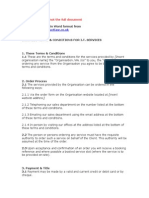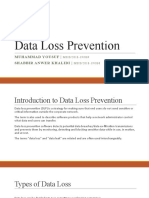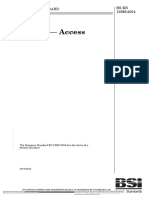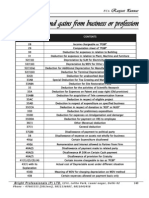Database Backup Systems
Uploaded by
mumtazoneDatabase Backup Systems
Uploaded by
mumtazone03.002 e2.
Database Backup Systems
CTRNet Standard Operating Procedure
Database Backup Systems
SOP Number: 03.002 Version: e2.0
Records Management and
Supersedes: 3.1.002 e1.0 Category:
Documentation
CTRNet Management Group (CMG) 01-May-2012
Approved By:
31-May-2012
Per: Brent Schacter
1.0 PURPOSE
Tumour biobanks are intended to manage the safekeeping of clinical data and other sample associated
data in their custody. CTRNet has policies regarding security safeguards to protect data and personal
information stored in its database against failure, loss and damage. Failure may occur due to user error
(modifying or destroying the data on its own or through a user choice), media failure (failure of equipment
such hard drive) or a catastrophic event such as a fire, flood, power outage, virus, or deliberate hacking.
The backup process must ensure the database can be completely and accurately recovered. CTRNet
recommends biobanks strive to ensure data can be fully recovered on a daily basis. The aim is to limit
data loss to no more than one day.
2.0 SCOPE
This standard operating procedure (SOP) outlines general elements and features that should be in place
to ensure that information stored in a database can be recovered accurately, completely and in a timely
manner.
3.0 REFERENCE TO OTHER CTRNET SOPS OR POLICIES
Note: When adopting this SOP for local use please reference CTRNet.
3.1 CTRNet Policy: POL 4 Privacy and Security
3.2 CTRNet Policy: POL 7 Material and Information Handling
4.0 ROLES AND RESPONSIBILITIES
The policy applies to personnel from CTRNet member biobanks that are responsible for the database
system and the safekeeping of sample and participant related information.
Tumour Biobank Personnel Responsibility/Role
Information Technology (IT) Staff Conducts backup/restores database according to specific
biobank plan.
Tumour Biobank Director, Manager, or Participates in development of biobank backup and
Principal Investigator. recovery plan. Outlines recovery expectations.
Tumour Biobank management Ensures adequate backup systems are in place
Copyright©2012 Canadian Tumour Repository Network (CTRNet). Page 1 of 4
03.002 e2.0
Database Backup Systems
5.0 MATERIALS, EQUIPMENT AND FORMS
Items listed in the following list are recommendations only and may be substituted by
alternative/equivalent products more suitable for the site- specific task or procedure.
Materials and Equipment Materials and Equipment (Site Specific)
Database back up system
Removable backup media
Offsite storage location
6.0 DEFINITIONS
See the CTRNet Program Glossary: http://www.ctrnet.ca/glossary
7.0 PROCEDURES
The facility must employ backup systems to protect the data stored on the database from damage and
loss. In the case of user error, media failure or catastrophic events, the system should ideally be able to
recover the information to or near the point before failure occurred. There should also be confidence that
the information is complete and free of corruption.
7.1 Database Backup – General Description of Process
7.1.1 Each biobank should develop a backup strategy based on:
• Database size
• Backup media available
• Database Management System (DBMS) used
• Recovery requirements (Acceptable data loss)
• Error detection. Undiscovered problems with data integrity that may require recovery from
one or more older archive sets to locate and correct the problem.
7.1.2 Upon development of an acceptable backup plan, IT staff at the biobank should implement
and monitor regular backups.
7.1.3 Send regular backup copies to offsite storage in case of fire, flood, earthquake or other “Acts
of God” which may destroy on-site archives.
7.1.4 Test data recovery at specific intervals as specified in the backup/recovery plan and record
results. Test both individual records and full database recovery. Be sure to test offsite
archival sets as well.
7.2 Database Backup – Routine Process
7.2.1 Routine steps will depend on the media used. Ideally, the backup system should be
automated and not require daily user intervention (manual changing of backup tapes for
instance) to reduce chance of error.
Copyright©2012 Canadian Tumour Repository Network (CTRNet). Page 2 of 4
03.002 e2.0
Database Backup Systems
7.2.2 Perform validation to ensure the nightly backup completed successfully. Investigate any
failed backups and resolve with the highest priority.
7.3 Database Backup - Frequency
7.3.1 Frequency is dependent on the recovery needs of the biobank. As a guideline the database
should be backed up nightly. In the event of catastrophic hardware failure, at most one day of
data entry or changes may be lost.
7.3.2 The maintenance of a standard archive set using current IT protocols is recommended.
7.3.3 Offsite Storage
a. CTRNet recommends (at minimum) monthly copies be sent offsite, weekly is preferred.
b. Where offsite storage is maintained, the service provider must be authorized by the host
institution to handle sensitive data.
7.4 Database Backup – Recovery Plan
Base the biobank recovery plan on acceptable data loss. The ability to recover data may also depend
on the system hardware and DBMS used.
7.5 Database Backup – Audit and Validation of Recovered Data
7.5.1 Develop a test plan to ensure backups are readable and store valid data.
7.5.2 Perform tests for full database recovery as well as individual record retrieval on a quarterly
basis.
8.0 APPLICABLE REFERENCES, REGULATIONS AND GUIDELINES
8.1 Tri-Council Policy Statement 2; Ethical Conduct for Research Involving Humans; Medical Research
Council of Canada; Natural Sciences and Engineering Council of Canada; Social Sciences and
Humanities Research Council of Canada, December 2010.
http://www.pre.ethics.gc.ca/eng/policy-politique/initiatives/tcps2-eptc2/Default/
8.2 Best Practices for Repositories I. Collection, Storage and Retrieval of Human Biological Materials
for Research. International Society for Biological and Environmental Repositories (ISBER).
http://www.isber.org/Search/search.asp?zoom_query=best+practices+for+repositories
8.3 US National Biospecimen Network Blueprint
http://biospecimens.cancer.gov/resources/publications/reports/nbn.asp
9.0 APPENDICES
None
Copyright©2012 Canadian Tumour Repository Network (CTRNet). Page 3 of 4
03.002 e2.0
Database Backup Systems
10.0 REVISION HISTORY
SOP Date
Author Summary of Revisions
Number revised
3.1.002 e1.0 2008 JdSH Original document.
3.1.002 e1.0 May 2012 CMG • Grammatical and formatting changes throughout
• Definitions removed
• Revision History moved to bottom
• Reference Links updated
• Updated SOP references
Copyright©2012 Canadian Tumour Repository Network (CTRNet). Page 4 of 4
You might also like
- That Time I Got Reincarnated As A Slime, Vol. 280% (5)That Time I Got Reincarnated As A Slime, Vol. 2282 pages
- IT Policies-Anti-Virus and Malicious Software Policy100% (2)IT Policies-Anti-Virus and Malicious Software Policy5 pages
- Policy On User Account Creation, Modification, and Deletion - 1100% (1)Policy On User Account Creation, Modification, and Deletion - 12 pages
- DAC 6000 4.x - System Backup and Restore Procedure Tech TipNo ratings yetDAC 6000 4.x - System Backup and Restore Procedure Tech Tip8 pages
- Data Center Infrastructure, Storage-Design Guide - SAN Distance Extension Using ISLs - Brocade Community Forums - 36627No ratings yetData Center Infrastructure, Storage-Design Guide - SAN Distance Extension Using ISLs - Brocade Community Forums - 3662711 pages
- Software Requirements Specification (SRS)No ratings yetSoftware Requirements Specification (SRS)10 pages
- Document Reference ISMS06005: ISO/IEC 27001:2013 Statement of ApplicabilityNo ratings yetDocument Reference ISMS06005: ISO/IEC 27001:2013 Statement of Applicability15 pages
- WTC Active Directory Integration - V2 PDFNo ratings yetWTC Active Directory Integration - V2 PDF14 pages
- Database Security and Auditing: Protecting Data Integrity and Accessibility100% (1)Database Security and Auditing: Protecting Data Integrity and Accessibility46 pages
- Purpose: Mobile Asset Management Policy I. Mobile Computing and Teleworking Select AllNo ratings yetPurpose: Mobile Asset Management Policy I. Mobile Computing and Teleworking Select All4 pages
- Automatically Forwarded Email Policy: 1. OverviewNo ratings yetAutomatically Forwarded Email Policy: 1. Overview2 pages
- ICT Data Backup and Recovery Policy 2019No ratings yetICT Data Backup and Recovery Policy 201916 pages
- Data Loss Prevention: Muhammad Yousuf - Shabbir Anwer KhalidiNo ratings yetData Loss Prevention: Muhammad Yousuf - Shabbir Anwer Khalidi13 pages
- Network Password Policy For IT Systems PDFNo ratings yetNetwork Password Policy For IT Systems PDF3 pages
- Computer security incident management Standard RequirementsFrom EverandComputer security incident management Standard RequirementsNo ratings yet
- CSA02 JournalEntry and Reconciliations Solution v1No ratings yetCSA02 JournalEntry and Reconciliations Solution v118 pages
- 10 Impl 35 SystemSetup UIConfigurationTemplatesNo ratings yet10 Impl 35 SystemSetup UIConfigurationTemplates28 pages
- CSI01 - Users and General AuthorizationsNo ratings yetCSI01 - Users and General Authorizations6 pages
- Injeel Barnabaas Urdu Pdfbooksfree - PKNo ratings yetInjeel Barnabaas Urdu Pdfbooksfree - PK442 pages
- Personal Best / Lesbian Feminist AudiencesNo ratings yetPersonal Best / Lesbian Feminist Audiences9 pages
- CBI Product Factsheet: Fresh Limes in The European MarketNo ratings yetCBI Product Factsheet: Fresh Limes in The European Market13 pages
- District & Sessions Court, Nagpur Judges List AS ON 07.10.2021 F.N. District Judge / Adhoc / MACTNo ratings yetDistrict & Sessions Court, Nagpur Judges List AS ON 07.10.2021 F.N. District Judge / Adhoc / MACT7 pages
- (Brometo de Litio) Eur J Org Chem - 2004 - Chakraborti - Lithium Bromide An Inexpensive and Efficient Catalyst For Opening of Epoxide RingsNo ratings yet(Brometo de Litio) Eur J Org Chem - 2004 - Chakraborti - Lithium Bromide An Inexpensive and Efficient Catalyst For Opening of Epoxide Rings5 pages
- Andreea Geana HMRC - About You ConfirmationNo ratings yetAndreea Geana HMRC - About You Confirmation2 pages
- Safety Data Sheet: 1 - Identification: Product Identifier and Chemical IdentityNo ratings yetSafety Data Sheet: 1 - Identification: Product Identifier and Chemical Identity6 pages
- IT Policies-Anti-Virus and Malicious Software PolicyIT Policies-Anti-Virus and Malicious Software Policy
- Policy On User Account Creation, Modification, and Deletion - 1Policy On User Account Creation, Modification, and Deletion - 1
- DAC 6000 4.x - System Backup and Restore Procedure Tech TipDAC 6000 4.x - System Backup and Restore Procedure Tech Tip
- Data Center Infrastructure, Storage-Design Guide - SAN Distance Extension Using ISLs - Brocade Community Forums - 36627Data Center Infrastructure, Storage-Design Guide - SAN Distance Extension Using ISLs - Brocade Community Forums - 36627
- Document Reference ISMS06005: ISO/IEC 27001:2013 Statement of ApplicabilityDocument Reference ISMS06005: ISO/IEC 27001:2013 Statement of Applicability
- Database Security and Auditing: Protecting Data Integrity and AccessibilityDatabase Security and Auditing: Protecting Data Integrity and Accessibility
- Purpose: Mobile Asset Management Policy I. Mobile Computing and Teleworking Select AllPurpose: Mobile Asset Management Policy I. Mobile Computing and Teleworking Select All
- Data Loss Prevention: Muhammad Yousuf - Shabbir Anwer KhalidiData Loss Prevention: Muhammad Yousuf - Shabbir Anwer Khalidi
- Computer security incident management Standard RequirementsFrom EverandComputer security incident management Standard Requirements
- M1.2: Define Information Technology ProcessesFrom EverandM1.2: Define Information Technology Processes
- CSA02 JournalEntry and Reconciliations Solution v1CSA02 JournalEntry and Reconciliations Solution v1
- CBI Product Factsheet: Fresh Limes in The European MarketCBI Product Factsheet: Fresh Limes in The European Market
- District & Sessions Court, Nagpur Judges List AS ON 07.10.2021 F.N. District Judge / Adhoc / MACTDistrict & Sessions Court, Nagpur Judges List AS ON 07.10.2021 F.N. District Judge / Adhoc / MACT
- (Brometo de Litio) Eur J Org Chem - 2004 - Chakraborti - Lithium Bromide An Inexpensive and Efficient Catalyst For Opening of Epoxide Rings(Brometo de Litio) Eur J Org Chem - 2004 - Chakraborti - Lithium Bromide An Inexpensive and Efficient Catalyst For Opening of Epoxide Rings
- Safety Data Sheet: 1 - Identification: Product Identifier and Chemical IdentitySafety Data Sheet: 1 - Identification: Product Identifier and Chemical Identity


































































































